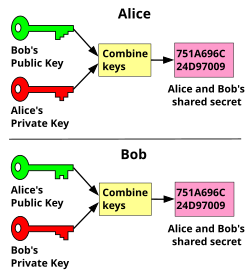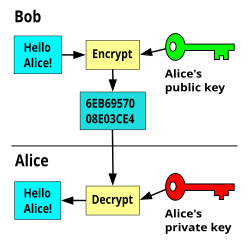
Back Publiekesleutelkriptografie Afrikaans تعمية بمفتاح عام Arabic Асиметричен шифър Bulgarian সর্বজনীন-চাবি ক্রিপ্টোগ্রাফি Bengali/Bangla Criptografia de clau pública Catalan Asymetrická kryptografie Czech Asymmetrisches Kryptosystem German Κρυπτογράφηση δημόσιου κλειδιού Greek Criptografía asimétrica Spanish Avaliku võtmega krüptograafia Estonian
This article needs additional citations for verification. (January 2024) |




Public-key cryptography, or asymmetric cryptography, is the field of cryptographic systems that use pairs of related keys. Each key pair consists of a public key and a corresponding private key.[1][2] Key pairs are generated with cryptographic algorithms based on mathematical problems termed one-way functions. Security of public-key cryptography depends on keeping the private key secret; the public key can be openly distributed without compromising security.[3] There are many kinds of public-key cryptosystems, with different security goals, including digital signature, Diffie-Hellman key exchange, public-key key encapsulation, and public-key encryption.
Public key algorithms are fundamental security primitives in modern cryptosystems, including applications and protocols that offer assurance of the confidentiality and authenticity of electronic communications and data storage. They underpin numerous Internet standards, such as Transport Layer Security (TLS), SSH, S/MIME, and PGP. Compared to symmetric cryptography, public-key cryptography can be too slow for many purposes,[4] so these protocols often combine symmetric cryptography with public-key cryptography in hybrid cryptosystems.
- ^ R. Shirey (August 2007). Internet Security Glossary, Version 2. Network Working Group. doi:10.17487/RFC4949. RFC 4949. Informational.
- ^ Bernstein, Daniel J.; Lange, Tanja (14 September 2017). "Post-quantum cryptography". Nature. 549 (7671): 188–194. Bibcode:2017Natur.549..188B. doi:10.1038/nature23461. ISSN 0028-0836. PMID 28905891. S2CID 4446249.
- ^ Stallings, William (3 May 1990). Cryptography and Network Security: Principles and Practice. Prentice Hall. p. 165. ISBN 9780138690175.
- ^ Alvarez, Rafael; Caballero-Gil, Cándido; Santonja, Juan; Zamora, Antonio (27 June 2017). "Algorithms for Lightweight Key Exchange". Sensors. 17 (7): 1517. doi:10.3390/s17071517. ISSN 1424-8220. PMC 5551094. PMID 28654006.